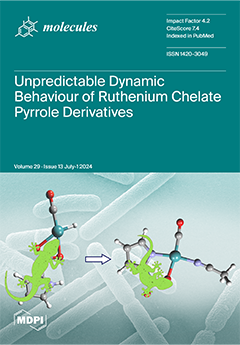Organometallic complexes of the formula [Ru(N^N)(
p-cymene)Cl][X] (N^N = bidentate polypyridyl ligands,
p-cymene = 1-methyl-4-(1-methylethyl)-benzene, X = counter anion), are currently studied as possible candidates for the potential treatment of cancer. Searching for new organometallic compounds with good to moderate cytotoxic
[...] Read more.
Organometallic complexes of the formula [Ru(N^N)(
p-cymene)Cl][X] (N^N = bidentate polypyridyl ligands,
p-cymene = 1-methyl-4-(1-methylethyl)-benzene, X = counter anion), are currently studied as possible candidates for the potential treatment of cancer. Searching for new organometallic compounds with good to moderate cytotoxic activities, a series of mononuclear water-soluble ruthenium(II)–arene complexes incorporating substituted pyridine–quinoline ligands, with pending -CH
2OH, -CO
2H and -CO
2Me groups in the 4-position of quinoline ring, were synthesized, for the first time, to study their possible effect to modulate the activity of the ruthenium
p-cymene complexes. These include the [Ru(η
6-
p-cymene)(pqhyme)Cl][X] (X = Cl
− (
1-Cl), PF
6− (
1-PF6), pqhyme = 4-hydroxymethyl-2-(pyridin-2-yl)quinoline), [Ru(η
6-
p-cymene)(pqca)Cl][Cl] ((
2-Cl), pqca = 4-carboxy-2-(pyridin-2-yl)quinoline), and [Ru(η
6-
p-cymene)(pqcame)Cl][X] (X = Cl
− (
3-Cl), PF
6− (
3-PF6), pqcame = 4-carboxymethyl-2-(pyridin-2-yl)quinoline) complexes, respectively. Identification of the complexes was based on multinuclear NMR and ATR-IR spectroscopic methods, elemental analysis, conductivity measurements, UV–Vis spectroscopic, and ESI-HRMS techniques. The solid-state structures of
1-PF6 and
3-PF6 have been elucidated by single-crystal X-ray diffraction revealing a three-legged piano stool geometry. This is the first time that the in vitro cytotoxic activities of these complexes are studied. These were conducted in HEK293T (human embryonic kidney cells) and HeLa cells (cervical cancer cells) via the MTT assay. The results show poor in vitro anticancer activities for the HeLa cancer cell lines and
3-Cl proved to be the most potent (IC
50 > 80 μΜ). In both cell lines, the cytotoxicity of the ligand precursor pqhyme is significantly higher than that of cisplatin.
Full article






